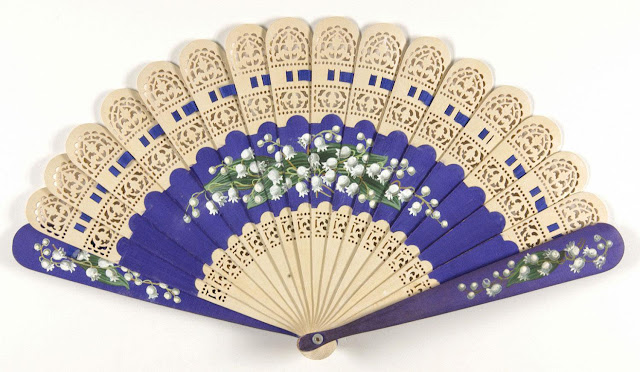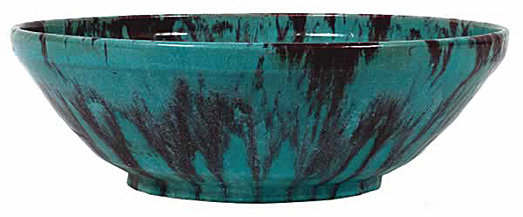 QUESTION: I was digging around in my mother’s attic the other day and discovered a flat box containing two very beautiful fans. I imagine these must have belonged to her mother or grandmother. What can you tell me about them? Do they have any value?
QUESTION: I was digging around in my mother’s attic the other day and discovered a flat box containing two very beautiful fans. I imagine these must have belonged to her mother or grandmother. What can you tell me about them? Do they have any value?ANSWER: Fans have been around for a long time. As a piece of functional art, they go back as far as ancient Egypt.
 The Egyptians saw them as sacred instruments used in religious ceremonies. They also became a symbol of royal power. But it was the Chinese who evolved the fan into a complex, decorated instrument. The Japanese took the fan one step further and produced a folding version, supposedly based on the folding wings of a bat. When Marco Polo returned to Venice, he brought with him fans made of vellum, paper, swan skin with blades of gold, silver, and inlaid mother-of-pearl.
The Egyptians saw them as sacred instruments used in religious ceremonies. They also became a symbol of royal power. But it was the Chinese who evolved the fan into a complex, decorated instrument. The Japanese took the fan one step further and produced a folding version, supposedly based on the folding wings of a bat. When Marco Polo returned to Venice, he brought with him fans made of vellum, paper, swan skin with blades of gold, silver, and inlaid mother-of-pearl.
 The original purpose of hand fans was to create a breeze, but they had many other uses. They could be used as protection against rain, as a tray for offering or receiving refreshments, and to hide bad teeth. European women would use fans to hide their faces during mass.
The original purpose of hand fans was to create a breeze, but they had many other uses. They could be used as protection against rain, as a tray for offering or receiving refreshments, and to hide bad teeth. European women would use fans to hide their faces during mass.
By the 18th century, the folding fan had come into its own in Paris. Delicately hand-painted floral motifs, on a structure of decorative sticks, came into common use. In fact, any wealthy lady worth her salt had to have fans as accessories to her wardrobe.
 These wealthy women developed a whole language of salutations and signals around their fans. For instance, carrying a fan in the left hand signified "desirous of acquaintance" while allowing it to rest on the right cheek meant "yes" and on the left "no." Drawing a fan across the forehead meant "We are watched" and drawing a fan across the eyes meant "I am sorry." Opening a fan wide meant "wait for me."
These wealthy women developed a whole language of salutations and signals around their fans. For instance, carrying a fan in the left hand signified "desirous of acquaintance" while allowing it to rest on the right cheek meant "yes" and on the left "no." Drawing a fan across the forehead meant "We are watched" and drawing a fan across the eyes meant "I am sorry." Opening a fan wide meant "wait for me."
Dropping a fan meant "We could be friends." If a lady fluttered her fan, it meant “I am married.” But if she placed the handle of her fan to her lips, it meant "kiss me." An open fan held in the right hand in front of the face—the ultimate form of seduction— meant "follow me"

The blades of these delicate instruments could be of carved ivory or tortoise shell inlaid with precious inlaid metals and elaborate jewels. Less expensive fan sticks were usually of sandalwood or fruitwood. These rococo fans were the finest ever made, and many fo the designs took the form of stylized art.
By the latter part of the 18th century, fans had gained popularity as a fashion accessory in the upper circles of American society. While fan makers imported finer sticks, they made their own wooden ones.
 The earliest fans made in any large quantity in the United States were paper souvenir fans depicting historical scenes. as well as current events. Lithographers portrayed views of New York's Crystal Palace, 1853, the Philadelphia Centennial in 1876, printed in black on a cream background, and the World's Columbian Exposition in 1893.
The earliest fans made in any large quantity in the United States were paper souvenir fans depicting historical scenes. as well as current events. Lithographers portrayed views of New York's Crystal Palace, 1853, the Philadelphia Centennial in 1876, printed in black on a cream background, and the World's Columbian Exposition in 1893.
By the late 19th century, fans displayed images of nearly every product. Every department store and every manufacturer advertised on fans, including such products as coffee, milk, bread, carpet sweepers, restaurants, cafes, theaters, sewing machines, etc.
 Before the advent of air-conditioning, funeral parlors gave out fans t mourners. These were as much to keep mourners cooler in warm weather as they were to wave the stink of the corpse away. These mourning fans became a social necessity. Manufacturers often fashioned them in black materials to coincide with the black clothing worn during recognized periods of mourning. Of course, it didn't hurt to print the name and address of the mortician on the guards of a cheap wood fan.
Before the advent of air-conditioning, funeral parlors gave out fans t mourners. These were as much to keep mourners cooler in warm weather as they were to wave the stink of the corpse away. These mourning fans became a social necessity. Manufacturers often fashioned them in black materials to coincide with the black clothing worn during recognized periods of mourning. Of course, it didn't hurt to print the name and address of the mortician on the guards of a cheap wood fan.
 Fans are still relatively inexpensive—except the jewel-encrusted ones—so they’re ideal to collect, especially for the novice collector. Many sell for $5-$20 online. Some of the most sought after fans came from the E.S. Hunt Company, later called the Allen Fan Company. In 1868, Hunt patented the process by which he assembled the fan sticks and the fan leaf in one step. This included folding or creasing and gluing the leaf to the fan sticks at the same time under pressure. This was America's first fan to appear and unfortunately folded, like its fans, in1910.
Fans are still relatively inexpensive—except the jewel-encrusted ones—so they’re ideal to collect, especially for the novice collector. Many sell for $5-$20 online. Some of the most sought after fans came from the E.S. Hunt Company, later called the Allen Fan Company. In 1868, Hunt patented the process by which he assembled the fan sticks and the fan leaf in one step. This included folding or creasing and gluing the leaf to the fan sticks at the same time under pressure. This was America's first fan to appear and unfortunately folded, like its fans, in1910.
Serious fan collectors often prize the simpler fans with printed leaves and plain sticks and guards. Many of these simpler folding fans provide a glimpse of particular times in history. Some once served as records of special occasions, such as births and marriages. Often fans celebrated military and naval victories. And some did the same for national holidays. Collectors find such a quantity of fans that many specialize in one particular subject, such as advertising fans. Unlike many other delicate antiques and collectibles, folding fans have survived for decades and often centuries in superb condition.
To read more articles on antiques, please visit the Antiques Articles section of my Web site. And to stay up to the minute on antiques and collectibles, please join the over 30,000 readers by following my free online magazine, #TheAntiquesAlmanac. Learn more about "The Art Deco World" in the 2024 Spring Edition, online now. And to read daily posts about unique objects from the past and their histories, like the #Antiques and More Collection on Facebook.










































